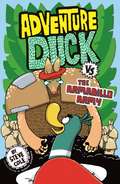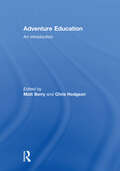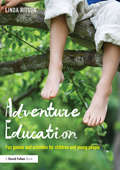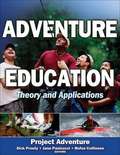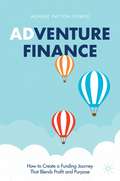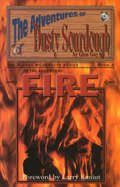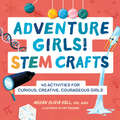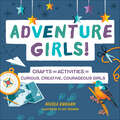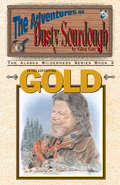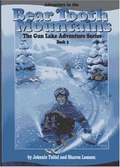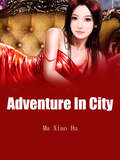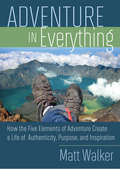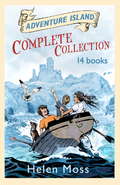- Table View
- List View
Adventure Duck vs the Armadillo Army: Book 2 (Adventure Duck)
by Steve ColeThe duck with the supersonic quack is back! Adventure Duck, the world's unlikeliest superhero, has a tasty new mission - saving the world from DEATH BY CHOCOLATE!Ay, caramba! Adventure Duck and his zebra sidekick, Ziggy, have a tasty new mission in Mexico. Their nemesis, Power Pug, has a dastardly new scheme to control the world's chocolate supply. With the help of a llama with projectile spit, Adventure Duck and Ziggy set out to foil the pug's nefarious plans to dig up the rainforest to build an enormous chocolate factory. But Armando the Commando and his army of armadillos stands in their way... Can the superhero amigos find a chink in the armadillos' armour and save the world from DEATH BY CHOCOLATE?
Adventure Education: An Introduction
by Matt Berry and Chris HodgsonAdventure Education is a form of experiential learning typically associated with activities involving risk, from cooperative games such as raft building to high adventure activities such as rock climbing. Adventure Education: An Introduction provides a comprehensive introduction to the planning, delivery and evaluation of Adventure Education, with a strong emphasis on professional practice and delivery. Written by a team of leading Adventure Educators who can draw upon an extensive experience base, the book explores the most important strategies for teaching, learning and implementation in Adventure Education. The book is fully illustrated throughout with real-world case studies and research surveying the key contemporary issues facing Adventure Education Practitioners. This includes essentials for the adventure educator such as risk management and tailoring activities to meet specific learning needs, as well as providing an insight into contemporary uses for adventure programmes. With outdoor and adventure activities being more popular than ever before, this book is essential reading for any student, teacher or practitioner looking to understand Adventure Education and develop their professional skills.
Adventure Education: Fun games and activities for children and young people
by Linda RitsonThis essential guide promotes learning through activity-centred adventure experiences, providing skill development, social education and personal development for practitioners, teachers, support staff and youth groups. This book offers advice and practical guidance on planning, setting up and running adventure education sessions with children and young people. Divided into two parts, it gives an overview of adventure education, explaining how it relates to holistic and outdoor learning and how it encourages active engagement from the learners as well as the instructors. Adventure Education provides a toolkit of various games and activities that can be used with groups of young children, including parachute games, card and musical activities, and climbing and traversing games. This book will be essential reading for all Early Years practitioners, Primary teachers and support staff wanting to develop their skills and deliver adventure learning effectively, as well as youth groups looking to provide informal learning as well as physical opportunities.
Adventure Education: Theory and Applications
by Dick Prouty Jane Panicucci Rufus CollinsonAdventure Education: Theory and Applicationsallows students to -get a broad view of adventure education and programming; -explore the role of games, low- and high-element courses, and outdoor pursuits in adventure education; -use key concepts, student activities, and Web-based research to enhance the learning process; -employ real-world examples to explore strategies for adventure education in a variety of settings; and -learn core skills for effective facilitation and leadership preparation in adventure programming. With Adventure Education: Theory and Applications, adventure education enters the educational mainstream. This comprehensive text is ideal for introductory adventure courses in a variety of college departments and as a reference for professionals in the field. Project Adventure, a leader in the field of facilities-based adventure learning, teams up with leading adventure educators and professionals to provide a broad view of adventure education and programming. Together, they present the foundational theories and applications of adventure education. In doing so, they -explore the role of games, low- and high-element courses, and outdoor pursuits in adventure education; -cover the core skills for effective facilitation and leadership preparation; -include student-friendly features, such as key concepts, summaries, student activities, additional readings, and Web-based research to meet students' levels of experience and enhance the easy delivery of the course; and -recommend strategies for adventure education and programming based on real-world examples that connect to a variety of recreational, educational, therapeutic, and community settings. Part Ipresents the history of adventure education as well as the numerous theories and philosophies that have informed its development. It explores the world of adventure in education, health care, and therapeutic, corporate, and school settings. It also provides an overview of adventure organizations and career options, which is helpful to students who are interested in pursuing the study of adventure. Part IIoutlines the technical and pedagogical skills needed for facilitating adventure experiences. Part IIIdescribes each adventure component, explaining how they work in the educational process. It covers facilities-based pursuits such as games, cooperative activities and initiatives, and challenge courses as well as outdoor pursuits. Some sample activities and many additional resources are provided. The final chapter covers models for programming adventure in educational, therapeutic, corporate, and community settings. For students who select careers in other fields, the leadership and team skills learned through Adventure Education: Theory and Applicationswill serve them well in their future workplaces. For students who do go into adventure education, this text is their guide for finding their own paths in the field.
Adventure Finance: How to Create a Funding Journey That Blends Profit and Purpose
by Aunnie Patton PowerThe venture capital model doesn’t work—at least not for 99% of startups and small businesses. In this 99% are a lot of companies with incredible potential: businesses headed by female founders and those from diverse racial backgrounds, organizations headquartered outside of venture capital hubs, and purpose-driven enterprises that are creating social and environmental impact alongside financial success. Counter to what the press-savvy venture capital world would have you believe, there are a lot of funding options out there for startups and small businesses. Adventure Finance is designed to help you understand some of these options, and walk you through real examples of how other founders and funders have put them to use. In simple, approachable language, the book breaks down the different types of funding options available from revenue-based financing to recoverable grants to redeemable equity to distributed ownership and more. Through a mix of storytelling and frameworks, based on a decade of research and experience in investing in early-stage companies, this book will give you the ability to determine how each of these structures can contribute to your own funding journey. The goal for this book is to shift the conversation about startup funding and help founders and funders widen the spectrum of “mainstream” investment options in order to make the venture financing world more inclusive and purpose-driven.
Adventure Fire: Adventures of Dusty Sourdough, Book 4
by Glen GuyOut of habit Dusty checked his Winchester to make sure a round was in the chamber, and then eased himself forward, keeping out of view of the front window. It was obvious to Dusty, because of the ruckus Little Bear was causing on the porch, that whoever was inside--if anybody--was forewarned, so the element of surprise was not in Dusty's favor. With these thoughts in mind, Dusty said to no one in particular, "Oh well," and he leaped to the porch, with his rifle at the ready. In an instant he was through the partially open door, ready for whatever consequence awaited him inside.
Adventure For Alison
by Elizabeth HowardAfter running away from their guardians to search for their older brother, Hugh, Alison and her twin, Gavin, find themselves aboard the Caroline, heading toward the colonies. They have heard that Hugh, because of his loyalty to the Stuart cause, has had to take refuge somewhere in the new world and they are determined to find him. It is not until they reach Boston that they realize they are to be sold as bond servants. Gavin is apprenticed to a bookseller and Alison is obliged to fit herself into the role of lady's maid to the spoiled Henrietta. Her life is no longer as carefree and easy as it was in Scotland, but her duties are not too difficult. After escorting Henrietta to Mrs. Bassett's school for young ladies she frequently has time to stop at the bookseller's shop to discuss plans with Gavin for finding their brother. On one occasion, while on an errand that leads her through Old Boston's narrow, winding streets, to her great dismay, Alison suddenly recognizes a familiar profile and she and Gavin are once more faced with the possibility of having to run away. Elizabeth Howard has chosen Old Boston with its busy streets and ship filled harbor for the background for this pre-revolutionary story and again she has created some convincing characters and an excellent plot. Ages 12-16
Adventure Girls! STEM Crafts: 40 Activities for Curious, Creative, Courageous Girls (Adventure Crafts for Kids)
by Dr. Megan Olivia Hall PhD, MEdInspire girls to build and create with fun, hands-on STEM crafts for ages 6 to 12 The world needs adventurous girls to lead the way to a brighter future! Help them discover new things about science, technology, engineering, and math (STEM) with this collection of engaging crafts for girls. As they learn and have fun with each project, they'll boost their critical-thinking skills, creativity, and self-confidence, too. What sets this book of STEM crafts apart: No parents required!—Encourage independence with arts & crafts that can be made with basic household materials and include kid-friendly, step-by-step instructions. Skill-building projects—Every project, from creating a Newton's cradle to knitting a DNA garland, incorporates basic STEM principles to help curious girls learn more about the world around them. Adventure girl challenges—Bonus activities and fun facts sprinkled throughout the book will inspire girls to dive deeper into the concepts and skills they're learning. Help girls have a blast discovering the secrets of the STEM universe through educational crafts for kids.
Adventure Girls!: Crafts and Activities for Curious, Creative, Courageous Girls (Adventure Crafts for Kids)
by Nicole DugganExplore, create, and imagine like a girl!Girls can do anything, and Adventure Girls! proves it! Packed with exciting activities and crafts for girls (ages 6 to 12), this book inspires young adventurers to be curious, innovative, and bold. From stargazing and animal tracking to making a pinhole camera and building a shadow theater, Adventure Girls! is not one of your typical craft books. It empowers girls to:Develop independence—Many of the activities are designed to be parent-assisted as girls learn to explore and create safely on their own.Delve into science—Discover scientific ideas and principles through constellation identification, bird watching, and compass making.Get their hands dirty—Adventure Girls! encourages outdoor play and exploration, from making a rope swing in the backyard to going on a nature scavenger hunt to building a shelter outside.Express their creative side—These crafts for girls also engage their artistic side, with activities like creating decorative 3D stars, pressing flowers, and folding (and inventing their own) paper airplanes.Instill confidence and curiosity with this collection of fun, engaging activities and crafts for girls.
Adventure Gold: Adventures of Dusty Sourdough, Book 3
by Glen GuyThe current was pulling at Dusty's legs. It was a sucking feeling and he knew that it was about to pull him under. There wasn't a thing he could do to stop it. The cold was numbing and his arms felt like lead. He struggled for one last deep breath as the surging water pulled him down. Down into what he thought would be his watery grave.
Adventure Group Psychotherapy: An Experiential Approach to Treatment
by Tony G. Alvarez Gary Stauffer D. Maurie Lung Kim Sacksteder Bobbi Beale Anita R. TuckerAdventure Group Psychotherapy: An Experiential Approach to Treatment explores what is necessary for an experiential therapy group to function effectively, and the practical skills needed to inspire success. The authors describe how to use activities in a manner that produces the greatest opportunity for clients to reach their goals. Issues such as how to actively assess client functioning in the group, how to select the appropriate activity, how to shape an effective environment, and how to help clients process their experience are a few of the aspects examined to help clients move toward their goals. The practical skills the authors describe enable readers to immediately learn and apply their practice with groups. This book will be an important tool in any group therapy class, in practice settings to train practitioners, and for any clinician trying to expand their group work capabilities.
Adventure In Bear Tooth Mountains
by Johnnie Tuitel Sharon E. Lamson<P>A three-family Christmas holiday promises hours of skiing, hiking and relaxing in the scenic Bear Tooth Mountains of Montana. At Eagle Mount, Johnnie learns how people with disabilities can snow ski and enjoy other activities. <P>But this isn't the only discovery he and his friends make. An abandoned shack near a deserted ghost town, a snowmobile chase and a blizzard provide a chilling adventures that tests the childrens' courage and survival skills.
Adventure In City: Volume 1 (Volume 1 #1)
by Ma XiaoHuI never thought I'd go to the nightclub! And also entered this line! The year he graduated, he was dumped by his girlfriend, humiliated by the rich and handsome, he lost his job, and his life was at rock bottom …Unintentionally passing by a KTV, attracted by the high recruitment notice …And from then on, I embarked on a life that I had never imagined …
Adventure In City: Volume 10 (Volume 10 #10)
by Ma XiaoHuI never thought I'd go to the nightclub! And also entered this line! The year he graduated, he was dumped by his girlfriend, humiliated by the rich and handsome, he lost his job, and his life was at rock bottom …Unintentionally passing by a KTV, attracted by the high recruitment notice …And from then on, I embarked on a life that I had never imagined …
Adventure In City: Volume 2 (Volume 2 #2)
by Ma XiaoHuI never thought I'd go to the nightclub! And also entered this line! The year he graduated, he was dumped by his girlfriend, humiliated by the rich and handsome, he lost his job, and his life was at rock bottom …Unintentionally passing by a KTV, attracted by the high recruitment notice …And from then on, I embarked on a life that I had never imagined …
Adventure In City: Volume 3 (Volume 3 #3)
by Ma XiaoHuI never thought I'd go to the nightclub! And also entered this line! The year he graduated, he was dumped by his girlfriend, humiliated by the rich and handsome, he lost his job, and his life was at rock bottom …Unintentionally passing by a KTV, attracted by the high recruitment notice …And from then on, I embarked on a life that I had never imagined …
Adventure In City: Volume 4 (Volume 4 #4)
by Ma XiaoHuI never thought I'd go to the nightclub! And also entered this line! The year he graduated, he was dumped by his girlfriend, humiliated by the rich and handsome, he lost his job, and his life was at rock bottom …Unintentionally passing by a KTV, attracted by the high recruitment notice …And from then on, I embarked on a life that I had never imagined …
Adventure In City: Volume 5 (Volume 5 #5)
by Ma XiaoHuI never thought I'd go to the nightclub! And also entered this line! The year he graduated, he was dumped by his girlfriend, humiliated by the rich and handsome, he lost his job, and his life was at rock bottom …Unintentionally passing by a KTV, attracted by the high recruitment notice …And from then on, I embarked on a life that I had never imagined …
Adventure In City: Volume 6 (Volume 6 #6)
by Ma XiaoHuI never thought I'd go to the nightclub! And also entered this line! The year he graduated, he was dumped by his girlfriend, humiliated by the rich and handsome, he lost his job, and his life was at rock bottom …Unintentionally passing by a KTV, attracted by the high recruitment notice …And from then on, I embarked on a life that I had never imagined …
Adventure In City: Volume 7 (Volume 7 #7)
by Ma XiaoHuI never thought I'd go to the nightclub! And also entered this line! The year he graduated, he was dumped by his girlfriend, humiliated by the rich and handsome, he lost his job, and his life was at rock bottom …Unintentionally passing by a KTV, attracted by the high recruitment notice …And from then on, I embarked on a life that I had never imagined …
Adventure In City: Volume 8 (Volume 8 #8)
by Ma XiaoHuI never thought I'd go to the nightclub! And also entered this line! The year he graduated, he was dumped by his girlfriend, humiliated by the rich and handsome, he lost his job, and his life was at rock bottom …Unintentionally passing by a KTV, attracted by the high recruitment notice …And from then on, I embarked on a life that I had never imagined …
Adventure In City: Volume 9 (Volume 9 #9)
by Ma XiaoHuI never thought I'd go to the nightclub! And also entered this line! The year he graduated, he was dumped by his girlfriend, humiliated by the rich and handsome, he lost his job, and his life was at rock bottom …Unintentionally passing by a KTV, attracted by the high recruitment notice …And from then on, I embarked on a life that I had never imagined …
Adventure In Everything: How The Five Elements Of Adventure Create A Life Of Authenticity, Purpose, And Inspiration (Adventure In Everything Ser.)
by Matt WalkerHave you ever wondered how others have reached their goals? Have you ever wanted to be more engaged and present? Have you ever wanted your life to be filled with adventure? Most of us have. It's important to note, though, that you don't need to climb Mount Everest, row across the Pacific Ocean, swim the English Channel, or ski to the North Pole to experience a life of adventure. In reality, finding it is a lifestyle choice that reconnects you with your dreams and passions. In Adventure in Everything, you'll learn a framework for making changes guaranteed to weave excitement and a sense of possibility into every single day. Whether it's finding a dream job, discovering a way to turn old responsibilities into new passions, enhancing your most significant relationships, or constructing a completely different way of being in this world, you have the potential for a life infused with exciting possibilities. With Adventure in Everything, you will discover this for yourself.
Adventure Island Complete 14 Book Collection
by Helen MossFrom finding hidden treasure to outwitting art thieves, no mystery is too big and no criminal too cunning for friends, Scott, Jack, Emily and Drift the dog. Together the gang have exciting adventures on the Cornish coast – whether it’s investigating a sinister phantom in THE MYSTERY OF THE MIDNIGHT GHOST or catching an unsual suspect in THE MYSTERY OF THE VANISHING SKELETON. Secret rooms, hidden caves and ancient treasures abound as the friends take on one intriguing case after another.
Adventure Island Complete 14-Book Collection
by Helen MossFrom finding hidden treasure to outwitting art thieves, no mystery is too big and no criminal too cunning for friends, Scott, Jack, Emily and Drift the dog. Together the gang have exciting adventures on the Cornish coast - whether it's investigating a sinister phantom in THE MYSTERY OF THE MIDNIGHT GHOST or catching an unsual suspect in THE MYSTERY OF THE VANISHING SKELETON. Secret rooms, hidden caves and ancient treasures abound as the friends take on one intriguing case after another.You can help solve all the mysteries with this complete collection of fourteen fabulous adventures in one book!
